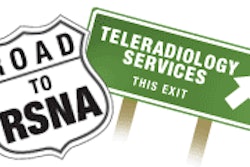CHICAGO - U.S.-trained and board-certified radiologists aren't the only ones who disapprove the use of foreign-trained, overseas radiologists to provide diagnostic imaging interpretative services for the U.S. healthcare market. Given a choice, referring physicians also express a strong preference for domestic radiology services, according to survey results presented at the 2006 RSNA meeting.
"Our objective was to evaluate referring physician attitudes toward nonemergent, final interpretation of radiologic images," said Dr. Neil Lester, a radiology resident at Staten Island University Hospital in New York City, at the conference on Tuesday.
Lester presented the results of research conducted under the direction of the department of diagnostic radiology at Yale University in New Haven, CT. The scientists created a five-question, scenario-based survey that described the features of a hypothetical local radiology firm compared with those of its hypothetical overseas counterpart, international radiology, Lester said.
The survey was sent by mail to 350 physicians representing a broad range of medical and surgical specialties, according to Lester. The group received 119 physician responses, for an overall survey response rate of 34%, he said.
The referring physicians were asked to indicate a preference in each scenario for the local firm versus the international firm using a five-point Likert scale (a tool used to measure attitudes, preferences, and subjective reactions). A mark of -2 indicated strong preference for the services provided by the international firm, a selection of 0 indicated no preference among the firms, and a mark of +2 indicated a strong preference for services provided by the domestic practice, according to the researchers.
With all variables held equal, referring physicians strongly preferred local services with a mean of 1.77 and a standard deviation (SD) of 0.77, Lester said. Demonstrating that sometimes its not always about the money, referring physicians still preferred services from the local firm when presented a scenario in which the international firm provided either a one-day faster turnaround time for reports or a $30 lower out-of-pocket cost to the patient; although Lester said it was less attractive, with a mean of 0.42-0.44 and an SD of 1.30-1.40, than it was with all variables held equal.
However, when faster service was offered along with lower costs, the referring physicians showed a true spirit of global citizenship by indicating a preference for interpretations provided by the international firm; but only slightly, with a mean of 0.25 and an SD of 1.50, according to Lester.
This preference for the international firm evaporated in a scenario in which the interpretations were conducted by foreign-trained radiologists under the supervision of an American Board of Radiology (ABR)-certified radiologist -- even when faster turnaround and lower cost was offered. Lester said that the referring physician group strongly preferred services from the local firm in this scenario with a mean of 1.51 and an SD of 0.86.
"To the extent that referring physicians represent the gateway to our practices, it's very important to interpret their preference and guide practice strategies accordingly," Lester noted. "If one provides timely high-quality interpretation, the risk of having one's work outsourced is low."
By Jonathan S. Batchelor
AuntMinnie.com staff writer
November 29, 2006
Related Reading
Demand rises for locum tenens radiologists, November 1, 2006
Multiple industry trends increase demand for subspecialty radiology, October 5, 2006
Malpractice insurance for teleradiology: What constitutes good coverage? March 21, 2006
Offshoring, teleradiology, and the future of our specialty, March 20, 2006
Russian teleradiology network meets needs, exceeds expectations, March 6, 2006
Copyright © 2006 AuntMinnie.com



















